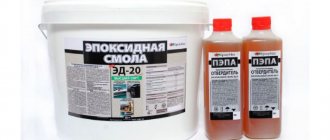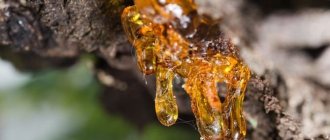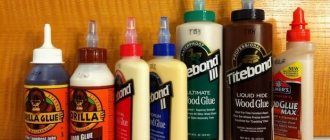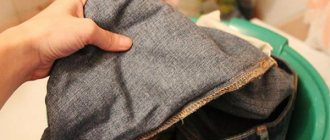To add to epoxy resin, a special additive is used - a hardener. Usually this composition comes complete with a resinous substance. But sometimes situations arise when it is necessary to dilute too thick a mixture of hardener + epoxy.
You need to know how to act correctly in this case.
Advice. To dilute a ready-made epoxy resin composition, it is better to use specialized solvents created to soften the resin solution.
Features of the material
The formation of cross-linked polymers inside an oligomeric synthetic compound is possible only under the influence of a hardener.
The unique properties of the material appear only after the two components are combined. The substance that is obtained after the polymerization reaction does not have a pungent odor. One of the characteristics of products made from epoxy resin is their high strength, resistance to mechanical stress and chemicals - acids, alkalis. EDP
In working condition, the consistency of the solution is liquid and viscous. This quality makes it possible to pour the composition into a mold for the manufacture of souvenirs and decorations, electrical parts, and furniture. After hardening, the composition becomes hard and durable, easy to process - trimming, grinding. The surface of the material after hardening is transparent, without foreign inclusions. Moreover, the resulting product is absolutely safe and non-toxic.
Consistency of the finished solution
The quality of a polymer product directly depends on maintaining the proportions when mixing the two main components. If the amount of hardener exceeds the recommended dosage, it will appear on the surface of the polymer. If there is not enough hardener, the polymerization process will not proceed correctly and the surface of the product will remain sticky.
Prices for different types of epoxy resin
Epoxy resin
Adviсe
When preparing the composition, as well as when applying it to the surface or filling molds with this glue, there are universal tips that help achieve better gluing.
When preparing the composition, it is better to use utensils and auxiliary tools that are unnecessary for further use. It is almost impossible to clean them from such a composition, so all used containers and mixing tools will be thrown away.
Pouring into the mold must be done in stages, especially if you plan to make the layer thickness more than 2 mm. After the first coating has polymerized, the next portion is poured only after the layer has cured, but with a sticky surface.
Where is it used?
The compound, popularly called “epoxy,” has a wide range of applications - from domestic needs to industry. The material is in demand in many industries, so its composition is regularly improved depending on the application. The material can be hard, soft, elastic or hard.
Using a compound to fill the countertop
Industries where the use of two-component compound is common
- Construction Epoxy waterproofing coating is widely used in basements and swimming pools.
- Mechanical engineering, shipbuilding, aviation and electrical industries - as a heavy-duty adhesive solution that guarantees long-lasting and strong adhesion.
- Furniture production - as a decorative element.
- Design – as a material for making accessories, souvenirs and jewelry.
Application of compound for making jewelry
A thin layer of polymer composition has high chemical resistance and water resistance, so the compound is popular for processing in the production of glass fabric and glass fibers. Also, hard and durable material is used in the manufacture of modern multi-chamber window systems.
Be careful!
Those who are planning to buy transparent epoxy glue in Moscow should also be aware that safety precautions must be taken when working with this product. In particular, it is prohibited to work with epoxies in a closed, unventilated area.
Inhaling the fumes emanating from epoxy resin can make a person feel sick. This means that access to open air is simply necessary.
If you do not have sufficient experience to confidently work with adhesives, we recommend that you use personal protective equipment. Otherwise, there is a possibility of accidentally sticking your hands together, damaging your skin, or staining your clothes.
When purchasing epoxy glue, always check its expiration date. An expired product is not only virtually useless, but can also be dangerous to human health when used.
It is also recommended to purchase epoxy only from trusted sales outlets where impeccable storage conditions are provided. For those who still have questions about how to properly use two-component epoxy adhesive, we recommend watching the video tutorial:
Basic properties of epoxy resin
- Wide range of uses.
- High strength and adhesive ability.
- Minimal shrinkage.
- Minimal moisture permeability after hardening.
- Excellent physical and mechanical properties.
- High adhesion to any materials.
- Elasticity.
- Dielectricity.
- Resistance to chemically aggressive substances.
- Anti-corrosion properties.
Jewelry making process
Methods of using epoxy compound
Common ways to use epoxy resin:
- Epoxy adhesive.
- Impregnating composition.
- Waterproofing composition.
- Material for manufacturing fiberglass by pouring or subsequent processing (cutting, grinding).
Pouring wood
Decor making kit
Since Soviet times, EDP, an epoxy adhesive consisting of ED-20 resin and PEPA hardener, has been widely used as an adhesive composition since Soviet times. Mix this composition in small quantities at room temperature. With a standard dosage of 1:10, deviations from the proportion are allowed, up to a ratio of 1:5.
Resin and hardener kit
If we compare ED-20 and ED-22 resins, the second has a lower viscosity. It is more convenient to use a composition of a more liquid consistency as an impregnating material, but the strength and heat resistance of such a coating will be less.
ED-20
Imported resins differ from domestic ones in their transparency and the absence of foreign inclusions. Moreover, their cost is sometimes even lower. An analogue of imported ED-22 is the German DER 330. Taiwanese resins 128 and 127, as well as Czech Epoxy 520, are distinguished by their viscosity and transparency.
Fast curing EDP glue
This product is sold in packages weighing from 45 to 250 g and consists of two ingredients - a resin with modifiers and a hardener. It is used in the following cases:
- elimination of cracks, defects, chips;
- sealing and repair of electrical appliances;
- connection of parts made of glass, ceramics, alloys, metal and others.
It is analogous to cold welding and is used in cases where rapid curing is required.
Purpose of hardeners
The role of the hardener is that it is not only a catalyst for the reaction, but also a full participant in it. The result is a compound of a certain consistency, suitable for work. And the resulting product after hardening will be reliable, durable and durable.
Modern compounds contain substances that accelerate the hardening process, which depends on the temperature of the solution and the type of hardener used. There are solutions on sale that harden even at low temperatures. Polymerization of some compositions is possible in conditions of high humidity.
Types of hardener
For domestic needs, a resin is used that hardens at normal temperatures; it is also called “cold-curing.” However, the most durable, chemically and mechanically resistant products are those obtained from hot-curing compositions.
The indicator of uniformity, hardness, durability and transparency of the composition depends on how accurately the proportion of the hardener is selected. Incorrectly selected quantity and mixing of components reduces the quality characteristics and affects the service life of the solution and the resulting product.
Varieties
The quality of the result is primarily affected by the type of hardener, not the resin. The most common low-cost varieties include PEPA and TETA hardeners. However, their quality is significantly lower than that of modified formulations.
Set with PEPA hardener
The main disadvantages of cheap compounds include the following:
- The temperature at which curing occurs for TETA is at least 30 degrees, for PEPA – 15 degrees.
- The compositions are vulnerable to moisture - this is a significant disadvantage when carrying out waterproofing work or when pouring a floor.
- Polymerization occurs quickly, so creating a thick layer is problematic.
As for modified compounds, these disadvantages are not typical for them. The only negative is the high cost.
Set with TETA hardener to obtain a clear solution
If we compare these two types of hardener, it is easier to work with PEPA, since it allows for slight deviations from the proportions and behaves well at room temperature.
Characteristics of different brands of hardener
TETA is an imported product, transparent, with low viscosity. There is a pungent odor. This hardener requires strict adherence to proportions.
Prices for theta hardener for epoxy resin
Theta hardener for epoxy resin
Epoxy painting.
How to paint epoxy? There are different ways to dye epoxy resin in different colors and for different needs. These needs can be divided into two types: decorative and technical.
Decorative epoxy painting.
Decorative painting of epoxy involves painting it in any color, adding and mixing special oil-based industrial dyes in any quantities for the sake of aesthetic characteristics. And as a result, neglecting the hardness and strength of the product. That is, here the aesthetic properties of an epoxy product (color, shade) and not the mechanical properties (strength, hardness) are put in first place. Decorative epoxy painting is used mainly in the manufacture of all kinds of hand-made souvenirs and jewelry, decorative crafts, etc. It should be said that the amount of added dye should not exceed 10% of the amount of epoxy. You can do more, but then the product will be too fragile or soft. To color the epoxy evenly, you first need to add the dye to the resin and stir it, and then add the hardener.
Technical epoxy painting.
Technical coloring of epoxy involves adding special dyes to it in small quantities that do not change its hardness and strength. Naturally, in this case the palette is rather sparse, but the goal here is no longer glamor, but industrial design and technical aesthetics while maintaining durability. For example, adding a small amount of printing toner to the resin will color the product black without changing its hardness. However, it is better not to paint critical and loaded adhesive joints and epoxy resin products at all. Or, if aesthetics are really necessary, paint it superficially.
Breeding rules
When diluting a two-component epoxy composition, strictly adhere to the dosage specified in the instructions.
Note! After the two components combine, an irreversible reaction occurs. Therefore, if you have to mix a large volume of resin, then first it is recommended to make several test mixes to determine the optimal dosage of the components.
Dosage of components
Sequencing
One method of mixing involves preheating the resin to a less viscous state, at which point it will not crystallize or boil. A sign that the resin has overheated is the formation of foam - if this happens, the composition can no longer be used. When the resin crystallizes, it is heated to 40 degrees with regular stirring, bringing it to its original transparent state.
The manufacturing process of the composition must take place using personal protective equipment
The heated resin is drawn up with a syringe and injected into a mixing container. The hardener is added in the same way. Using a wooden spatula, mix the ingredients thoroughly.
In everyday life, a small amount of solution may be needed, for example, for gluing parts. In this case, cold mixing technology is used. The proportion is 1:10 , where the first value is the resin, and the second is the hardener. The air temperature should not exceed 25 degrees.
In any case, experts recommend performing a test mixing to identify the most correct proportion and only then using the entire volume of components available for work.
Note! When mixing the composition in a “cold” way, heat is released during the reaction process. If the volume is large, then the amount of thermal energy will be significant. As a result, polymerization will occur very quickly, and the composition will lose its suitability for use.
If the hardener dosage is incorrect, the resin will boil
A sign of a high-quality composition is the absence of air bubbles, viscous consistency and absolute transparency.
If it is necessary to obtain a large volume of working composition, then “water bath” technology is used to heat the resin. The temperature of the substance should rise to 50 degrees. Due to this, the volume of the solution suitable for use increases and its viability is extended (on average by 1-2 hours).
In this case, the heating temperature should remain uniform throughout the entire time. When it increases to 60 degrees, polymerization will inevitably occur, and the composition will be spoiled. It is also important to prevent water from getting into the compound - the composition will become cloudy and lose its adhesive properties.
Table 1. Preparation instructions.
| Illustration | Description |
| The container is placed on the scales and reset to zero. | |
| Pour the required amount of resin. | |
| Pour in the hardener. | |
| For 5 minutes, thoroughly mix the components with a wooden stick so that as few air bubbles as possible form in it. | |
| The solution is ready for use. |
Prices for PEP hardener for epoxy resin
Pape hardener for epoxy resin
Video - What should you consider when diluting epoxy resin?
The role of plasticizer
It may often be necessary to add the plasticizer DEG-1 or DBP to the composition before adding the hardener, in an amount of 5 - 10% of the total resin volume. In this case, the proportion changes - the hardener is taken not 10, but 5 parts, pouring it in a thin stream. This eliminates the brittleness and fragility of the cured product.
Plasticizer DEG-1
A plasticizer is required when making large-format EPS products. By adding it, it is possible to prevent the formation of cracks during the hardening process.
DBP is a universal plasticizer with a wide range of uses. The specificity of its use with epoxy resin is the need to slowly cook the resin with DBP at a temperature of 60 degrees and vigorous stirring for 3 hours. In this case, the plastic effect will be minimal, but sufficient to prevent cracking of the product during hardening. Due to the evaporation of DBP, the ductility of the product will be reduced over time. The dosage of this type of plasticizer should not exceed 10%.
Plasticizer DBP
Another type of plasticizer, DEG-1, has been developed for working with epoxy resins. The proportion may vary, but is usually between 5 and 10%. The greater the amount of DEG-1 added, the more expressive the plastic effect will be - in the cured state, the resin may have the consistency of bitumen. The resulting resin is modified with a long shelf life. The downside of DEG-1 is its brown tint - transparent products cannot be made from it.
Note! The greater the plasticity of the product, the less its mechanical strength.
Solution pot life
Prices for DEF plasticizer for epoxy resin
DEF plasticizer for epoxy resin
How to dilute epoxy
Diluting the glue must be done carefully, so it is important to prepare protective equipment and working tools in advance.
Rubber gloves and a protective mask are necessary to prevent damage to the skin and respiratory system, because both ingredients are quite toxic. It is also important to prepare mixing containers and sticks. It is important to ensure ventilation of the work area.
Diluting the glue must be done carefully, so it is important to prepare protective equipment and working tools in advance.
Ratio norms
In order to properly dilute epoxy glue, the proportions must be strictly observed. Typically, purchased chemicals come with instructions. It specifies mixing rules and proportions. To mix the composition, it is usually necessary to maintain a ratio of 10 to 1. That is, for 10 parts of the resin volume, take 1 part of the hardener.
Previously, for convenience, manufacturers produced formulations in containers with divisions. Today, you can use various available means for this.
In order to properly dilute epoxy glue, the proportions must be strictly observed.
Adding color
The epoxy resin is given color before it hardens.
It is important to know the physical and chemical properties of the dye and the mass itself to obtain the desired result. It is important to choose non-aqueous based materials when painting epoxy.
For successful coloring of the mass, it is important to follow the following recommendations:
When using oil paint, it is important that the mass of the dye does not exceed a tenth of the total volume; Do not allow moisture to get into the mixture; Ventilate the room well; It is necessary to work with resin at a temperature not lower than 22 degrees.
The color is added to the epoxy resin before it hardens.
It is better to use special pigments for coloring epoxy. They are presented in a wide range in construction stores. There are several types:
- Plain. Can be from white to black, as well as bright shades;
- Fluorescent. The composition includes a phosphor. This ensures the product glows in the dark;
- Matte. The presence of a special substance in the composition ensures a matte surface.
You can also use improvised means for coloring.
But it is important to consider that they can interact with each other. Also, this is not always advisable due to the low cost of piments
The following options can be used:
- Ink from ballpoint pens;
- Nitro dyes;
- Pencil leads;
- Printer toners;
- Dry pigments;
- Artistic oil paints;
- Alkyd dyes.
It is better to use special pigments for coloring epoxy.
How to mix at home
Before diluting epoxy resin, you need to read the instructions and study all the nuances. At home, you can only mix small volumes of resin. This can be done in a cool room. When working with large volumes at home, the composition immediately begins to harden due to the heat generated.
First, mix small volumes, and only then move on to larger ones. This is necessary in order to ensure that the proportions are selected correctly.
Substances are dosed using different syringes. Their size is selected taking into account the working volumes. Both components are poured into the prepared container and mixed thoroughly. There should be no air bubbles in the resulting mass. The finished mass should be transparent and uniform. After receiving the composition, you can add dyes and perform all the necessary work.
At home, you can only mix small volumes of resin.
Precautionary measures
When working with EPS, it is necessary to follow basic safety rules.
- The room in which the compound is diluted must be well ventilated.
- Children and animals are not allowed to the work site.
- When diluting the composition, personal protective equipment is used: respirator, gloves, goggles.
- The work is carried out in special clean clothes, from the surface of which particles and threads will not get into the solution.
- Surrounding objects and furniture are also protected from accidental contact with the compound, which cannot subsequently be removed.
If the resin gets on the skin, wash it with acetone and soapy water.
Compliance with safety measures
Specifications
EDP epoxy adhesive has some technical characteristics that must be taken into account when using the material. Among them, the following deserve special attention:
- Excellent mechanical strength. The adhesive seam from EAF will not collapse even under active mechanical stress.
- Low shrinkage. Allows you to accurately calculate the thickness of the seam when gluing parts.
- Excellent compatibility with most materials.
- Electrical insulation ability. A material such as EAF glue is positioned by manufacturers as a dielectric.
- Resistant to water and damp environments. The created adhesive seam will have waterproof properties.
- Post-processing compatible. When the adhesive joint has completely cooled, it can be processed. In particular, it withstands sanding, polishing, sawing and painting.
Making a vase from pencils and epoxy resin
Epoxy resin is easy to use and allows you to create unique decorative items. As an example, consider the process of making a vase from ordinary colored pencils.
Table 2. Vase made of colored pencils.
| Illustration | Description |
| Compliance with safety measures | You can use a small plastic bucket as a basis. The bottom of the future vase is formed using a circle cut from a thick piece of plywood, which will be placed on the bottom of the bucket. |
| The outline is outlined and cut out using a jigsaw. | |
| The top cover is made in the same way. | |
| A circle with a smaller diameter is placed on the bottom of the bucket. | |
| Lay out the pencils. | |
| A cavity is formed inside using a plastic cup. | |
| They insert the oppression - a glass filled with cement. | |
| Measure out the required amount of resin. | |
| Add the required amount of hardener. | |
| The composition is thoroughly mixed for 5 minutes. | |
| Carefully pour the voids between the pencils so that they stick securely together. | |
| Set oppression for 24 hours. | |
| The pencils are cut into several pieces to be placed on the bottom. | |
| Empty the inside of the workpiece and place cut pencils on the bottom. | |
| Prepare the required amount of composition. | |
| Fill the bottom. | |
| Set oppression for 24 hours. | |
| Remove the workpiece. | |
| Drill a hole. | |
| The workpiece is fixed on a lathe. | |
| The product is given the required shape. | |
| The plywood bottom-stand is cut off. | |
| The product is sanded and varnished. |
Vase of colored pencils
If there is a style that can be easily recognized without being an interior design specialist, it is the loft. The appearance of a residential or office space, similar in content to an industrial one, leaves no doubt about its identity. What to pay attention to when designing an office in the loft style? More details in a special article.
What it is?
Epoxy glue is a synthetic product based on epoxy resin. French chemist Castan discovered epoxy resin in 1936. This fact served as an impetus for the development of the chemical industry. The fact is that by adding various substances to the resin, many new materials can be obtained. Epoxy resins are used to produce adhesives and casting compounds, plastics, varnishes and many other products for various industries.
In physical form, resin can be a thick viscous liquid, transparent white, yellow and dark red in color, or a solid brown mass. The substance is characterized by resistance to halogens, some acids and alkalis. To obtain an adhesive composition, various components are added to it: hardeners, solvents, fillers and plasticizers.
The main characteristics by which epoxy adhesive is classified include the following:
It can be of two types in composition.
- One-component adhesives use liquid or solvent resin. The product is packaged in tubes and is ready for use without preparation. It is used for gluing small parts or sealing gaps.
- Most often, epoxy glue is two-component. It is sold as a kit, which includes two tubes. One tube contains resin in paste form, the second contains a hardener in liquid or powder form. The contents of the two tubes are mixed and used immediately, since after some time the mixture loses its ability to stick together. Most manufacturers produce two-component glue. Its application is almost universal.
There are two types of glue consistency.
- Liquid glue has the appearance of a gel. It saves time as it does not need to be prepared, and is also convenient for application to the surface.
- The plastic mass will have to be prepared. To do this, cut off the required amount from the contents of a cylindrical tube or bar, knead it with your hands and moisten it with water. The plastic mass is great for repairing chips, holes, and other defects.
The curing method divides adhesives into the following types:
- in the first, curing occurs at room temperature;
- the second must be heated before introducing the hardener.











